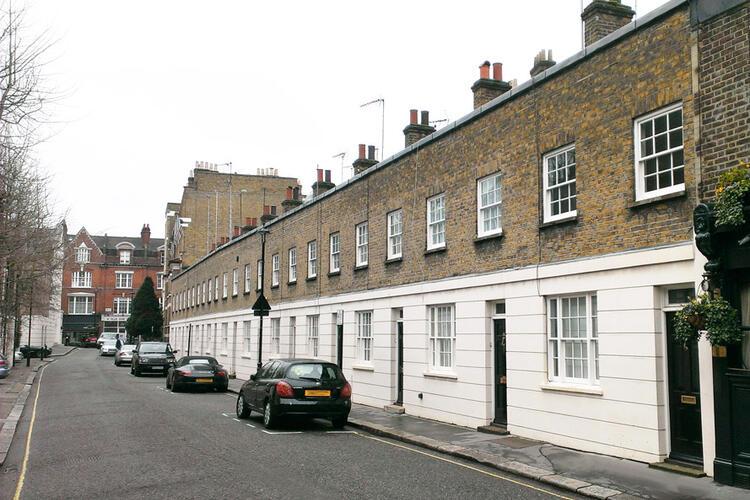Grosvenor Britain & Ireland Achieves Passivhaus First at 11 and 19 Passmore Street
27 May 2016Grosvenor Britain & Ireland Achieves Passivhaus First at 11 and 19 Passmore Street
27 May 201611 and 19 Passmore Street are the first privately rented buildings in London to achieve the EnerPHit Passivhaus standard. Developed by Grosvenor Britain & Ireland, the refurbished properties give customers the best of both worlds – the appeal of a period home at a quality above new build. Building on the success of this project, Grosvenor is already upgrading more buildings to the EnerPHit Passivhaus standard.
Key Facts
- Excellent thermal performance and sound insulation
- Clean air, with ducts filtering 80% of large dust particles
- £900 annual energy cost savings for occupiers
- 804 tonnes less CO2 over the lifespan of the buildings
- Passivhaus Award 2015
Situation
Grosvenor, an international private property group, works in some of the most dynamic cities around the globe. Guided by their ‘Living cities’ philosophy, the team strives to create, manage and invest in properties and places that contribute to the enduring success of cities.
11 and 19 Passmore Street are historic 1860s terraced houses, situated in a conservation area in Belgravia, Westminster. They were identified as pilot projects to support Grosvenor’s commitment to reduce CO2 emissions by 50% across its directly managed London estate portfolio by 2023.
This project also offered Grosvenor the opportunity to test the EnerPHit Passivhaus standard in period homes, focusing on building fabric, energy efficiency, comfort and indoor air quality. Grosvenor owns many period properties in London and seeks to conserve historic fabric, while delivering homes for customers that are fit for purpose, sustainable and a pleasure to inhabit.
The project team included Sturgis Carbon Profiling (architect and Passivhaus consultant), Edward Pearce (mechanical and electrical consultant), Grangewood (contractor), Hurst Peirce + Malcolm (structural engineer) and CoCreate (Passivhaus certifier).
Actions
Construction began in March 2014 and completed in January 2015. Both properties were occupied in February 2015.
Insulation and air tightness measures included:
- Efficient, breathable aerogel internal insulation to the front (0.16 U value).
- EPS external wall insulation with brick slips to rear (0.11 U value), applied to the whole street of 12 terraced houses, with additional PIR insulation applied internally to the two Passivhaus buildings.
- Mineral wool and PIR board on the roof (0.10 U value) and internally where moisture risks were low to reduce costs.
- Triple glazed, mock-sash timber windows to the front, which open inwards so they can be made airtight (1.18 U value) and triple glazed casement windows to the rear (0.68 U value).
Additional Passivhaus measures included:
- Mechanical ventilation with heat recovery (MVHR), with air ducts that filter 80% of large dust particles.
- 12 photovoltaic roof panels to generate clean power.
- Full monitoring equipment, including internal and external temperatures, relative humidity, CO2 sensors, electricity sub-metering, heat flux meters on heating and on domestic hot water pipework.
Financials
- Project costs: 17%-19% higher than a typical refurbishment for this pilot project. However, Grosvenor estimates that the premium for retrofitting historic buildings to Passivhaus standard will ultimately be reduced to 5%, as project teams become more experienced.
- Rental premium: none currently, but as consumers become aware of the benefits of Passivhaus, in terms of comfort, health and energy bills, the standard should contribute to a rental premium and reduced voids.
- Energy savings: £900 estimated annual saving for occupiers.
Benefit
- High comfort levels, with excellent thermal performance and sound insulation, clean air, a consistent temperature and no draughts, so occupiers feel healthier.
- 80% better energy efficiency than a neighbouring property that underwent a standard refurbishment, resulting in lower energy bills and reduced emissions.
- EnerPHit Passivhaus standard, which Grosvenor believes will increasingly be recognised by consumers as the platinum standard for healthy building, enhancing the buildings’ marketability.
- 95% operational CO2 reductions, compared to pre-project, and 75% whole life CO2 reductions, including embodied emissions of materials. This will result in 840 tonnes less CO2 over the buildings’ 60-year lifespan.
- Convenience, with occupiers not needing to change their lifestyles to reap the efficiency and health benefits.
Challenges and Achievements
TEAM
How to get team buy-in for Passivhaus?
This was the first time Grosvenor, Grangewood or Sturgis had delivered a Passivhaus project, and so team training was key to success. The whole team visited the Target Zero Passivhaus training centre in Ireland before work began on site. Sturgis also provided extensive training on air tightness and other Passivhaus concepts to the builders and subcontractors, such as electricians and plumbers. In addition, Grosvenor partnered with Grangewood, the company’s preferred builder for domestic retrofits, rather than using a normal competitive tender, with the entire team focused on Passivhaus from the outset.
AIR TIGHTNESS
How to locate and fix air leaks in period homes?
Grosvenor recommends air testing below 50 air changes per hour (ach) until the air tightness membrane is covered, to avoid damage due to over-pressure. At 11 Passmore Street, continuous air testing at high pressure during building works caused delays as membranes were pulled apart at taped joints. The detailed air tightness work to locate and fix air leaks contributed to the preliminary phase taking longer than expected. The team carried over lessons to 19 Passmore Street, speeding up the process. The first air tightness test at No 11 came in at around 6ach, and it took two more weeks of sealing to get it down to 0.8. Whereas, the first test at No 19 came in at 1.2ach, and it took just one day’s work to get down to 0.9, within the Passivhaus target of 1.0.
CONDENSATION
How to avoid causing condensation when insulating historic buildings?
Internal insulation can create a ‘dew point’ between the new insulation and the old wall, where the temperature drops and water vapour condenses to liquid, potentially leading to mould. At 11 and 19 Passmore Street, the team stripped back the fabric and carried out masonry repairs to ensure all brickwork was in good condition. Then they applied aerogel insulation, a highly insulating, breathable material to further reduce the risk of condensation. Sturgis also designed out thermal bridges, points where cold structures penetrate the insulation layer, to eliminate possible dew points. They prepared 26 individual thermal bridging details and carried out 3D thermal modelling of the building's steel supports. In addition, the front façades at 11 and 19 Passmore Street are rendered, which helps prevent rain and moisture getting into the building fabric.
Find out more
Mike Levey
Retrofit Project Manager
Grosvenor Britain & Ireland
www.grosvenor.com
*Please note that the information on this page was supplied by the BBP Member and the BBP assumes no responsibility or liability for any errors or omissions in the content


